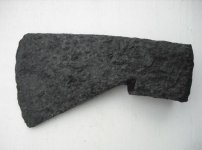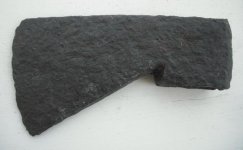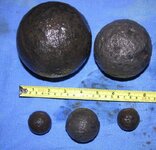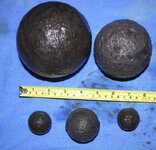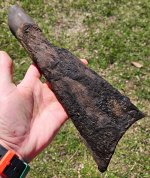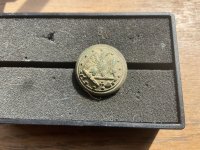romeo-1
Gold Member
Having recently found my first trade axe, in absolutley awesome condition, i decided that I wasn't going to procrastinate and let the rust continue eating the relic, I was going to clean and preserve it immediately. I had previously tried electrolysis on a couple mortar frags and was not at all impressed with the results. This is probably owing to my inexperience with the method as I have seen some awesome relics restored using this method, ColonialDude for one is an absolute expert with this. I was hunting with The Patriot when I found the trade axe and it was he who turned me on to the "zinc and lye" method. Of course I had been aware of the method but never gave any real thought to trying it. Patriot showed me a couple of his own trade axes that he had preserved using this method (they looked great) so I resolved to give it a try.
Here is a picture of the trade axe in "as found" condition. Covered in soil and rust. The condition was great, even the bit is unbroken.
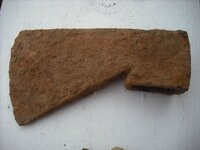
The first step to restoring this relic was to remove the soil. That was easy, run a garden hose over it and wash it off. Here is a picture of the axe after the initial rinse. As you can see, there is a heavy layer of rust over the iron.
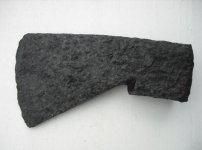
Now it is time to remove the rust. OK, first probllem, where do I get lye and zinc. A quick Google search showed me that there are several sources of zinc available at any hardware store. I went with zinc wall anchors. I found a pack of 100 for $10. Lye was a little more difficult to find, our local hardware store no longer carries it so i had to travel tot he "next town over" and found a hardware store that did still carry it. I bought a 3kg container for $18.00. For those who are not aware, lye is extremely caustic and will burn flesh on contact. It comes in the form of crystals that are water soluable.
So, now I have the zinc and the lye...what the heck do I do with it? Well, let me tell you. I place half of the zinc wall anchors into a large plastic bucket. I then place the trade axe on top of the zinc anshors and place the rest on top of th axe. Now, wearing a long sleeve shirt, rubber gloves and protective eyewear I pour approximately 2 cups of the lye over the zinc and axe...but it gets even more dangerous! I then pour enough boiling water into the bucket so that it completely covers the
axe and zinc. Pour the water down the side of the bucket so that it does not splash back at you. DO NOT BREATHE IN THE VAPORS FROM THE REACTION!!! There will be a boiling reaction when the hot water hits the lye and zinc. It is of course safest to do this outside. At this point the zinc is being sacrificed as the corrosion goes from the iron to the zinc. After approximately four hours I checked the axe and noted that a large amount of rust has come away from the axe, the water in the bucket was very brown by this point. I then added another cup of lye to the water and left it for another 20 hours.
After a total of 24 hours I removed the axe from the lye water finding that 99% of the rust was gone. I used a brass brush to remove the remainder of the rust and now have a rust free relic. Here is a picture of the axe fress out of the water.
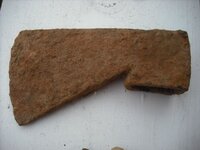
Now, if you do not treat the relic it was start to rust again. There are several ways to preserve the raw iron including waxes and laquer. The goal is to keep the air and moisture away from the relic. I decied to try a little semi gloss satin clear laquer applied thinly...or so I thought. This is where the accidental nature of this process occurrs. I let the axe dry for 24 hours including a couple hours in the oven. I hung the axe from the ceiling in my garage and hit it with some Krylon semi-gloss satin. I probably sprayed a little too much because when I was done I saw that the clear finish was opaque and not very attractive. I let it completely dry and for reasons unknown I sprayed another coat on thinking that this would get rid of the opaqueness...duh! After the second coat the finish was so opaque that it was nearly white...now I started to panic! The only thing I could think of is I need to get this laquer off this axe before it completely dries. I tried to wipe it off with a shop rag but that only made the problem worse...the finish was tacky so the rag made it worse. I did not have any paint thinner so I grabbed the only thing I had...a gas jug. I poured the gas into a bucket and dropped the axe in. I really don't know what I was thinking but this laquer was not coming off in the gas...but the opaqueness was now gone...but the laquer was still coating the axe. I took another shop rag and went to town wiping down the axe. This was essentially polishing the laquer that was still on the axe. I wiped it for about 10 minutes and was quite impressed when I was finished. The axe was coated but the finish looks very natural. There is a slight sheen, which is desired, but it is not overwhelming. I'm pretty confident that the elements will not contact the iron thus not more oxidation...and it looks way cool. To get rid of the gassy smell I just left it axe out in the sun for a few hours to evaporate...voila! The finished product!
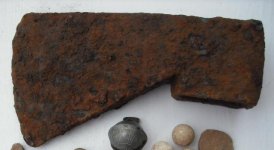
Here is a picture of the trade axe in "as found" condition. Covered in soil and rust. The condition was great, even the bit is unbroken.

The first step to restoring this relic was to remove the soil. That was easy, run a garden hose over it and wash it off. Here is a picture of the axe after the initial rinse. As you can see, there is a heavy layer of rust over the iron.

Now it is time to remove the rust. OK, first probllem, where do I get lye and zinc. A quick Google search showed me that there are several sources of zinc available at any hardware store. I went with zinc wall anchors. I found a pack of 100 for $10. Lye was a little more difficult to find, our local hardware store no longer carries it so i had to travel tot he "next town over" and found a hardware store that did still carry it. I bought a 3kg container for $18.00. For those who are not aware, lye is extremely caustic and will burn flesh on contact. It comes in the form of crystals that are water soluable.
So, now I have the zinc and the lye...what the heck do I do with it? Well, let me tell you. I place half of the zinc wall anchors into a large plastic bucket. I then place the trade axe on top of the zinc anshors and place the rest on top of th axe. Now, wearing a long sleeve shirt, rubber gloves and protective eyewear I pour approximately 2 cups of the lye over the zinc and axe...but it gets even more dangerous! I then pour enough boiling water into the bucket so that it completely covers the
axe and zinc. Pour the water down the side of the bucket so that it does not splash back at you. DO NOT BREATHE IN THE VAPORS FROM THE REACTION!!! There will be a boiling reaction when the hot water hits the lye and zinc. It is of course safest to do this outside. At this point the zinc is being sacrificed as the corrosion goes from the iron to the zinc. After approximately four hours I checked the axe and noted that a large amount of rust has come away from the axe, the water in the bucket was very brown by this point. I then added another cup of lye to the water and left it for another 20 hours.
After a total of 24 hours I removed the axe from the lye water finding that 99% of the rust was gone. I used a brass brush to remove the remainder of the rust and now have a rust free relic. Here is a picture of the axe fress out of the water.

Now, if you do not treat the relic it was start to rust again. There are several ways to preserve the raw iron including waxes and laquer. The goal is to keep the air and moisture away from the relic. I decied to try a little semi gloss satin clear laquer applied thinly...or so I thought. This is where the accidental nature of this process occurrs. I let the axe dry for 24 hours including a couple hours in the oven. I hung the axe from the ceiling in my garage and hit it with some Krylon semi-gloss satin. I probably sprayed a little too much because when I was done I saw that the clear finish was opaque and not very attractive. I let it completely dry and for reasons unknown I sprayed another coat on thinking that this would get rid of the opaqueness...duh! After the second coat the finish was so opaque that it was nearly white...now I started to panic! The only thing I could think of is I need to get this laquer off this axe before it completely dries. I tried to wipe it off with a shop rag but that only made the problem worse...the finish was tacky so the rag made it worse. I did not have any paint thinner so I grabbed the only thing I had...a gas jug. I poured the gas into a bucket and dropped the axe in. I really don't know what I was thinking but this laquer was not coming off in the gas...but the opaqueness was now gone...but the laquer was still coating the axe. I took another shop rag and went to town wiping down the axe. This was essentially polishing the laquer that was still on the axe. I wiped it for about 10 minutes and was quite impressed when I was finished. The axe was coated but the finish looks very natural. There is a slight sheen, which is desired, but it is not overwhelming. I'm pretty confident that the elements will not contact the iron thus not more oxidation...and it looks way cool. To get rid of the gassy smell I just left it axe out in the sun for a few hours to evaporate...voila! The finished product!



